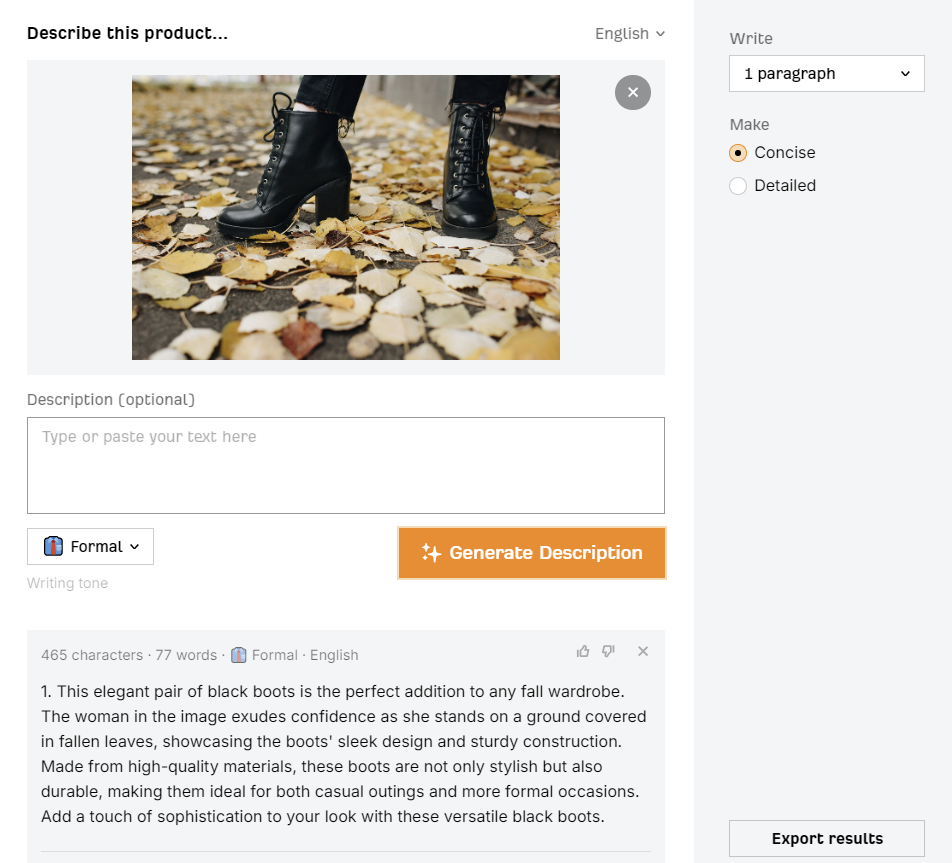
Table of Contents
Product Data Enrichment: Solutions and Techniques
Incomplete data from suppliers is an extremely common challenge for most retailers. The outcome of not having enough quality information about the product often results in generic product descriptions which in turn leads to negative customer experience and decreasing sales.
If the data suppliers provide is not sufficient, manual product data enrichment becomes necessary. At that point, additional problems arise since the manual data enrichment process is not only time-consuming but also requires close familiarity with products that e-commerce specialists commonly lack.
Luckily technological solutions are available to address these challenges. In this article, we will explore top product data enrichment techniques and solutions that will assist retailers in optimizing customer experiences, boosting eCommerce revenue, and playing a significant role in your SEO performance. But before we get started, let’s clarify the terms…
What is product data enrichment?
Product data enrichment is the process of enhancing and expanding product information to make it more detailed, accurate, and useful for customers. This typically involves adding attributes, descriptions, images, specifications, and other relevant information to product listings. The goal of data enrichment is to provide customers with a better understanding of the products, improve search relevance, enhance user experience, and ultimately drive sales.
Why is Product Data so Important in eCommerce?
Enriched product data is the key to optimizing customer experiences. Providing customers with detailed and accurate information about products means answering all their potential questions in advance, demonstrating transparency, building trust and meeting expectations.
High-quality product data directly impacts eCommerce revenue. When customers are presented with compelling and informative product information, conversion rates tend to increase, ultimately leading to greater revenue generation.
On top of that, enriched product data also plays a crucial role in SEO. Beyond just improving the shopping experience, it enhances search engine visibility. This, in turn, drives increased traffic to the eCommerce platform and helps in securing better rankings on search engine results pages.
AI-tools for Data Enrichment
Automatically describing products by their images is a revolutionary data enrichment technique that is being implemented by businesses in 2024. Currently, AI tools promising quality product descriptions from product images are on the rise. The examples include:
- Microsoft Azure Vision Studio
- Pixellow ChatGPT Plugin
- Pallyy
- Astica Vision AI
- Gemini Vision models
- Ahrefs’ Product Description Generator
Enriching product data with AI tools is already changing how businesses manage and present their offerings. This is a common scenario when a retailer has product images but lacks descriptions, especially when dealing with a large number of products.
Fortunately, some AI tools, like Astica Vision AI, are capable of processing a high volume of images quickly, making it feasible to generate descriptions for a large library of products.
The quality of the descriptions generated by these AI tools is quite high. They go beyond basic object recognition to capture emotions and the overall atmosphere of the image. However, relying solely on AI for product descriptions is not the ultimate solution yet. Often, these descriptions will still lack specific details such as the brand, material composition, available sizes, or special features (unless you do not specify these details manually in advance). What is more, without being given enough details in the first place, AI description generators commonly make up some characteristics and those educated guesses of neural network are not always close to the truth and may mislead your potential buyers. Additionally, many essential aspects such as pricing, maintenance requirements, or any limitations in terms of weather resistance or long-term durability are not visually perceivable.
Let's take a look at an exemplary description generated by Ahrefs' Product Description Generator.
 Without providing any specific details about the product, what we will end up with is a well-written yet quite generic description that focuses more on the background details and characteristics of the model. A description like this does not provide enough factual information to the buyers and does not answer all their questions about the product.
Without providing any specific details about the product, what we will end up with is a well-written yet quite generic description that focuses more on the background details and characteristics of the model. A description like this does not provide enough factual information to the buyers and does not answer all their questions about the product.
 If specifying the attributes of the product to the description-generating AI tool, we will surely get a more informative description without extra water.
This is a huge leap forward in terms of efficiency and scalability but still not quite enough for the more thoughtful practical buyers. Providing more comprehensive information is necessary to help potential buyers make a more informed purchasing decision. Yet, to be able to provide AI tools and your buyers with the practical information they need, you have to import, sort out, update, and store that information in an organized and centralized manner, and this is where the Product Information Management System comes into play.
If specifying the attributes of the product to the description-generating AI tool, we will surely get a more informative description without extra water.
This is a huge leap forward in terms of efficiency and scalability but still not quite enough for the more thoughtful practical buyers. Providing more comprehensive information is necessary to help potential buyers make a more informed purchasing decision. Yet, to be able to provide AI tools and your buyers with the practical information they need, you have to import, sort out, update, and store that information in an organized and centralized manner, and this is where the Product Information Management System comes into play.
PIM Solution for Enriched Product Data
When faced with the need to enrich the data for tens of thousands of products, manually describing products by pictures no longer seems like a reasonable strategy.
A solution to that is **a centralized data point like a PIM system, which is extremely useful in such a scenario since it enables conducting mass updates and assigning one attribute to multiple products at the same time.
Massively importing data from files is highly beneficial, as it allows for the aggregation of information from multiple sources to achieve the highest quality of descriptions. Massive imports/exports of data are easily automated with the assistance of a PIM system.
A PIM system is a software solution designed to centralize and streamline the management of product information across an organization. It serves as a centralized repository where businesses can store, organize, and enrich product data, including specifications, descriptions, images, and other relevant attributes. PIM systems provide tools and functionalities to manage product data efficiently, ensuring consistency, accuracy, and completeness across various channels and touchpoints.
With a PIM system, you can properly facilitate the abovementioned data enrichment techniques, empowering businesses to manage their product data more efficiently and effectively. One of the trusted open-source PIM solutions is AtroPIM. With a PIM system like AtroPIM, businesses can effectively handle the complexities of product data management, enhance data quality, and deliver compelling product experiences to customers.
Implementing Product Classifications
Think about a clothing distributor specializing in T-shirts, who might consider the following attributes to describe this product effectively: material, fit, neckline, sleeve length, color, design, size range, gender, style, brand, price…
The list of attributes can go on and on, and all these attributes are useful for producing quality and comprehensive product descriptions that sell. Moreover, since all online stores rely on product attributes for product filtering, effectively describing a product by its attributes means allowing potential buyers to find it through these same attributes with filters. The Product Information Management system (PIM) facilitates the creation of unified product descriptions by utilizing classifications. This means that when you assign any of your products to a particular classification, the system will prompt you to specify all the required attributes associated with that classification. A PIM system enables every user to create their own classification systems.
Best Practices for Data Enrichment with AtroPIM
Implementing best practices for data enrichment with AtroPIM allows you to:
- Ensure reproducibility and consistency: AtroPIM ensures consistent and reproducible outcomes in data enrichment tasks, which allows businesses to maintain high standards of data quality.
- Design tasks to be rules-driven for consistent outcomes: By leveraging AtroPIM's rule-based approach, businesses can streamline data enrichment processes and achieve consistent outcomes across different datasets.
- Set clear evaluation criteria: Businesses can establish clear criteria for evaluating the quality and effectiveness of data enrichment efforts, ensuring that they meet the desired objectives and standards.
- Assess and compare outcomes with prior jobs: AtroPIM's reporting, and analytics features enable businesses to assess the success of data enrichment jobs over time and compare outcomes with previous efforts for continuous improvement.
- Grow and scale: AtroPIM supports scalability and allows businesses to handle growing volumes of product data and enrichment tasks with ease, ensuring that they can meet the evolving needs of their eCommerce operations.
- Address diverse needs: AtroPIM offers flexibility and versatility to address a wide range of data enrichment needs, catering to the diverse requirements of eCommerce businesses across different industries and sectors.
Key Takeaways
In conclusion, effective product data enrichment is crucial for eCommerce success. By implementing best practices for data enrichment, businesses can optimize customer experiences, increase revenue, improve SEO rankings, and stay competitive in the online marketplace. Implementing a PIM system, AI tools, or a combination of both can streamline the data enrichment process, ensuring comprehensive and accurate product information.


